CHAPTER 4
The Common Soul Theory of Leadership
CHAPTER OBJECTIVES
After studying this chapter, you should be able to:
- Understand the basic contours of the Common Soul theory of leadership.
- Apply the basic theory to current and past situations involving leadership.
Introduction
In this chapter, we discuss the basic premise of the book; the main body of our majestic leadership elephant. It is presented as a theory called ‘Common Soul theory of leadership’. Through this theory, we wish to understand the basic phenomenon of leadership as relevant to man. Like any other theory, there are some basic assumptions on the basis of which a theory is developed. Aspects of this theory can be related to things we observe in the world around us and this also includes the conclusions and applications that come out of it. And the better understanding of these conclusions and applications helps us in better dealing with matters concerning leadership. The attempt in this chapter would be to clearly understand the basic propositions of the theory.
Consider the following situation:
A biker has apparently taken a fall and there is a small group of people gathered around and no one seems to be doing anything about it.

While this is happening one of them comes forward.
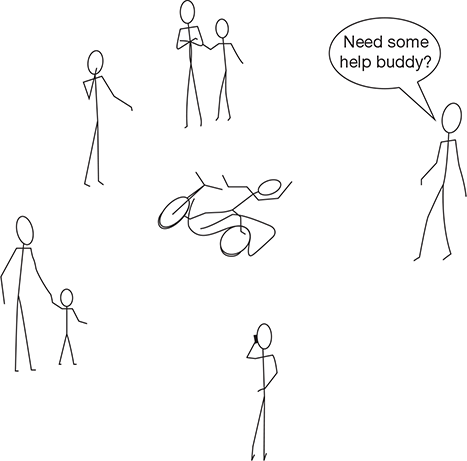
His coming forward seems to have made them all join in to help out.
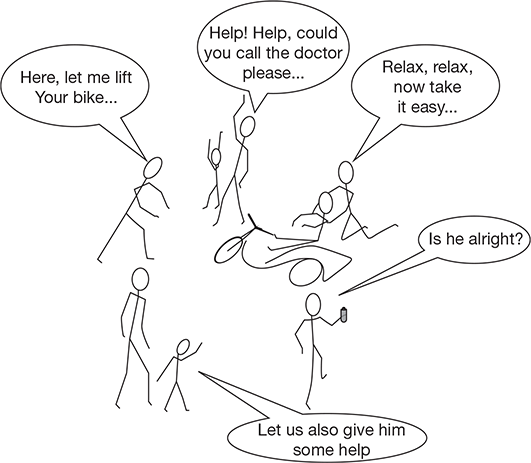
They all seem to feel some sense of satisfaction by having done what they did.
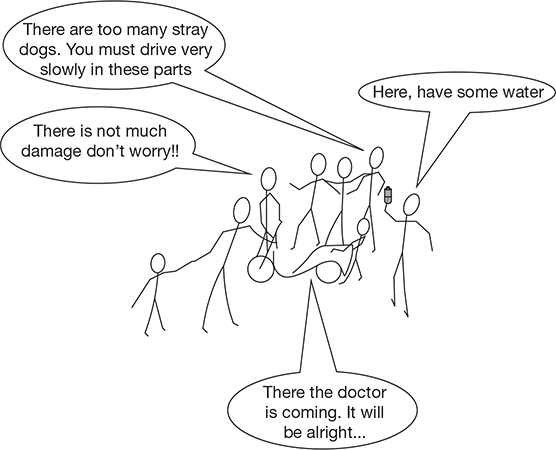
These pictures indicate a sequence of events that seems normal in the situation. And the person who took initiative is generally identified as the leader in the situation, and the others have followed suit and done the needful.
There is a need to observe human interactions more closely.
Now, let us look at the same sequence of events through a different perspective. The Common Soul theory proposes that there were certain other things that happened in the background which went unnoticed. It takes into consideration a certain additional parameter, which for our convenience we will refer to as the ‘Common Soul’. Now this Common Soul is hypothesized to be the same in all individuals.
Reconsider the same sequence of events but this time reckoning some additional steps as follows … . A person is lying on the ground and all of them get a ‘signal’ from their ‘Common Soul’ … .
In order to explain the happenings, the Common Soul theory proposes that there is an impulse felt from the ‘Common Soul’ which is uniform in individuals uniformly.
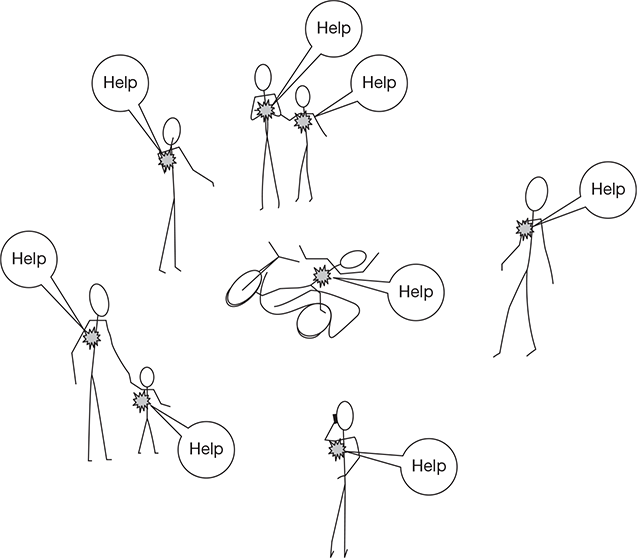
In all of them correspondingly thoughts are ignited, however the thoughts that arise need not be necessarily in sync with what the ‘Common Soul’ is saying … .
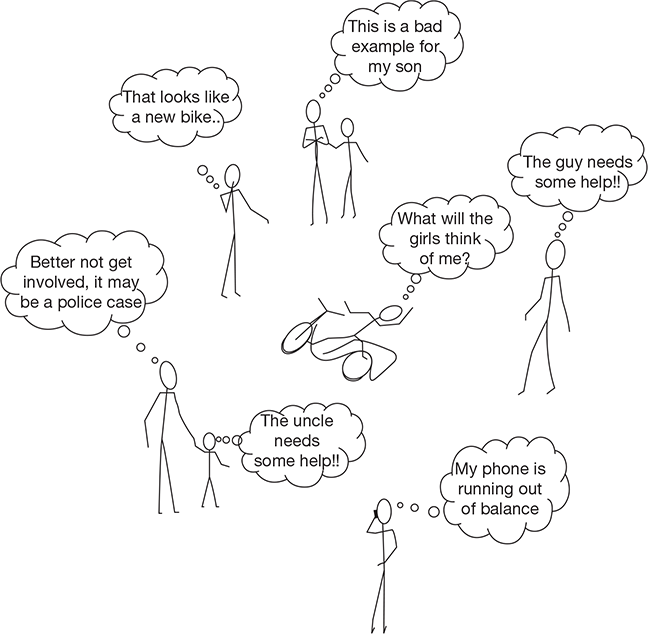
The thought processes in the mind need not reflect the impulse of the ‘Common Soul’.
Subsequently, all of them say/do something that is in accordance with their respective thoughts.

The thoughts and actions of some people are in sync with the ‘Common Soul’.
Seeing one of them taking the step forward and helping out, all the others find a new set of thoughts arising in them … . and speak and act accordingly … .
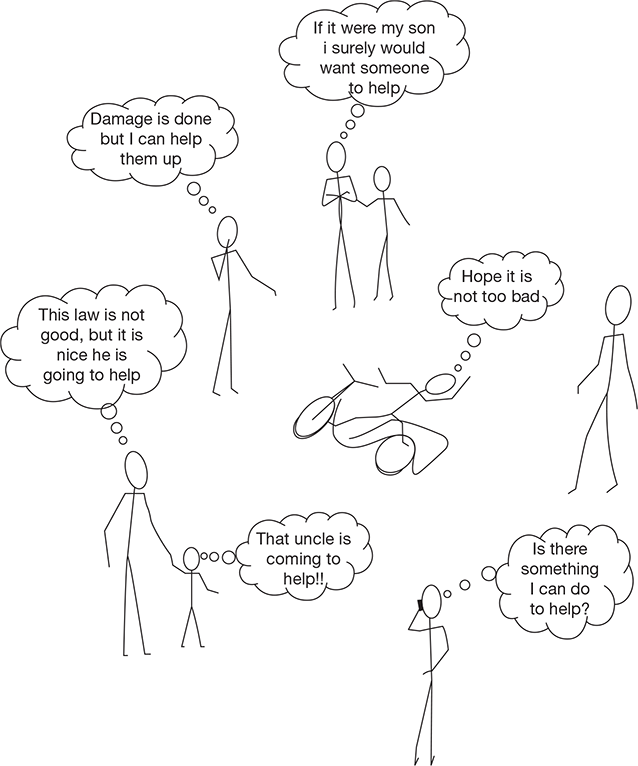
They all seem to have found some resonance with what the person with initiative has done and somehow their thoughts are related to the urge of ‘help’ that had originally arisen within them … .
Actions soon follow accordingly … .
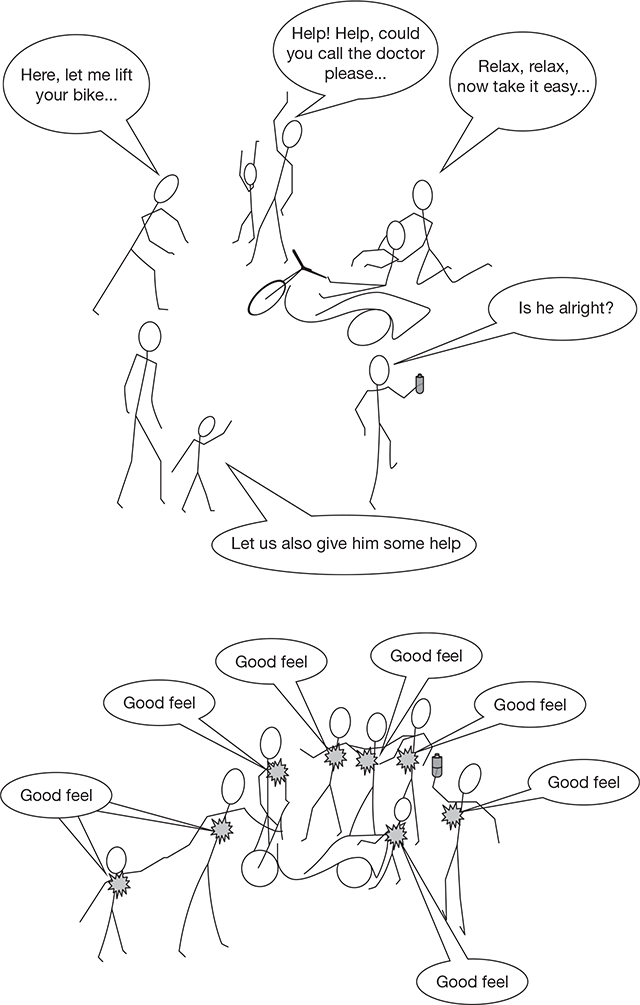
The Overall Frame-work of the Common Soul Theory of Leadership
This entire sequence actually brings to light a certain parameter called ‘Common Soul’ … . This ‘Common Soul’ is supposed to have the following characteristics:
- Sameness: It is the same in all humans irrespective of age, sex, belief, etc.
- Link across bodies: We humans are all connected in this Common Soul.
- Feeling heart (not physical heart): There is the (notional) place connected with each individual from where the urge springs forth as desired by the Common Soul and only later it is taken up by the mind-body mechanism.
The Common Soul is proposed to have certain qualities relevant to leadership that can be compiled from ancient and contemporary findings on human spirituality.
- Real boss: The Common Soul is supposed to be the primary engine in all humans. It is considered to be the source of joy in an individual; satisfaction and contentment are supposed to spring from there, the urge to live and the urge for happiness too are supposed to come from there. When a person finds himself in any particular situation, it is said that it is the Common Soul that triggers the response—which is ideal for that situation.
- The problem with humans: The ‘Common Soul’ may give the right trigger all right, however there is a possibility that this trigger may be misread by the concerned individual. Therefore, out of this misreading the response which the individual gives may not be ideal (in accordance with the Common Soul) and it could be miscued.
- The leader does not have this problem: The leader is distinguished from the others by the fact that his faculties are in tune with this Common Soul. He knows to read what the Common Soul wants.
Further, since he can read/feel what the ‘Common Soul’ wants, he also ‘voices’ what comes from there and ‘acts’ in consonance with it too. Therefore, when seen by a neutral observer, a leader’s words and actions seem to be the best suited for the given situation.
- Even the non-leader types can be helped: The theory also goes on to suggest that if one cannot read what the Common Soul has to say (to himself); he could be sensitized to it by external stimuli. One of the ways (as indicated in the example in this chapter) is through watching an example set by a leader. This can help people identify what truly satisfies them from within and make them act according to it. Thus, leadership can be exerted by example.
- The power of leadership: The theory further implies that the Common Soul also holds the key to the power exerted by leaders. When people observe a leader why do they feel impelled to follow him? The reason suggested is that the impulse of the Common Soul is as strong within the followers as within the leader himself. When followers follow the leader they get to do what the Common Soul wants—what their true nature desires from them—and as a result experience contentment and satisfaction.
The power wielded by a leader is a manifestation of the power wielded by the Common Soul on each individual.
Therefore, the power of leadership is not achieved by a leader through addressing the followers’ sense of material wants and security needs but rather by awakening their inner interconnectedness with others. In fact, it is said that followers follow leaders, in spite of themselves, because the Common Soul within is truly the master—because of the power and significance in which the Common Soul, by nature, holds in each individual life. The power of leadership, therefore, as exerted by true leaders, is driven from the inside of followers. Or in other words, leadership will have as much sway over people as the Common Soul has over each individual.
Is This a Discovery or an Invention?
The theory in its entirety is surely fascinating; it almost sounds like it is taken straight out of a fiction book or film—the force of Star Wars or Eiwa of the Avatar fame for example. It can be argued that a spark of each ‘force’ is present in every individual—in the respective movie. But what if there truly exists something like the Common Soul and what if more or less this is how it impacts everyone?
On the contrary, if there is, then why is this Common Soul not evident to everyone? Why only a few know about it … . ?
Experts say that the Common Soul is an observable but it is only subjectively possible; not objectively.
When those who are masters in this field are asked, ‘Can the Common Soul be touched … . ?’ They say ‘No, it is not touchable … .’
Can it be heard … . ? ‘No, the ear cannot pick it up … .’
Can it be seen … . ? ‘No, it is not composed of light … .’
Does it have a taste … . ? ‘No, it is beyond the sensing ability of the tongue … .’
Can anyone smell it … . ? ‘No, it has no olfactory attributes to it … . so the nose cannot detect it … .’
But by that exhausts all five human senses. Anything that is beyond the five senses may or may not exist, but we cannot come to know of it through our senses. So then, how does one accept that it does exist … . ?
To which the experts respond that:
- The Common Soul can be seen only by itself and
- This ‘seeing’ happens only when the ‘mind becomes thoughtless’.
Can this be taken at face value? How does the Common Soul see itself? What is the mind and how is it made thoughtless?
When a Student Searches for Evidence
The ideas relating to the Common Soul are surely not easily digestible to the rational mind. There are those who have tried to do justice to the task of finding the truth about this and are quite convinced that it is like chasing a red herring … . And even so, there are others who have indicated that this pursuit is worth it and that it does yield genuine results …
Searching for direct evidence of Common Soul within the domain of mind and thought is futile.
Maps are available; predecessors who claim success have left behind sign posts and milestones for students to follow. And it is advisable that the students use these when they set on the quest.
A Consolation Even for those Who Don’t Get Evidence
Now, despite all his efforts, if a student does not get evidence for the Common Soul, he is not able to see it and he does not understand how it works … Can he still grow up to be a leader?
Search for evidence of Common Soul can be postponed while in the mean while benefitting from the applications.
The answer is yes … . He can still be a leader; and he can do this by practicing the ‘applications’ of the proposed model. We shall see more of this in the rest of this section.
But before we get to that, let us summarize the important components of this theory into axioms … .
Summary
The Common Soul theory of leadership is comprised of the following:
Axiom 1 There is something called Common Soul which is the same in everyone, is the primary igniter for thought within individuals, it is interconnected in all humans and is a powerful engine within them.
Axiom 2 The leader is tuned to the Common Soul; he knows what the soul desires; the thoughts in his mind reflect the feeling he has in his ‘feeling heart’; he also speaks and acts exactly according to both his feelings and thoughts. Therefore, the leader has integrity; meaning that his feelings, his thoughts, his words and actions do not contradict each other … .
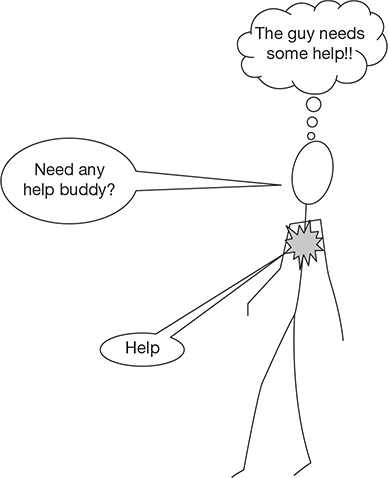
Axiom 3 People who are not tuned to the Common Soul are not able to listen to what they feel from within. The thoughts in their minds are different from what feelings they have. Their words and actions are also confused and could even contain deceit.

Axiom 4 Those who do not listen to the Common Soul are losers in two ways:
- They are not able to lead because what they say can be at variance with what the Common Soul desires and therefore they tend to be confused and also confuse followers. They also appear non-inspiring.
- Because of the lack of integrity within themselves, they are also low on excellence. Experts say that the inability of the mind to read what the Common Soul has to convey is on account of various personality hurdles within the individuals. The hurdles like people’s individuality, ego, personal aspirations, and non-impersonal goals all come in the way. These negative traits are also said to be coincident with lack of excellence, tendency to get lost in the past and the future, inability to be alive to the present moment, tendency for anxiety and anger, being aimlessly lost in desire, incompetency and much more … .
Axiom 5 When those who are unable to read the Common Soul witness true leaders, they are inspired and feel compelled to do what these leaders do. They feel connected to what they have now taken up due to their own natures. It is as if they also feel that they are exactly doing what they want to do as it all seems satisfying in some mysterious way.
In Conclusion
This therefore encompasses the Common Soul theory of leadership. The brief definition would be as follows:
The Common Soul theory of leadership states that there is a Common Soul in all humans which is the real driving force and is the true centre of satisfaction, contentment and joy in humans. A leader is one who can read clearly what the intent of the Common Soul is and can help his followers see the same, make them act according to its wishes and therefore help them derive the highest satisfaction in their work and life.
As we go along through the rest of the book, let us see the implications of referring to the Common Souls as the pivot around which leadership happens. We will now move on to explore the various nuances of this approach in greater detail. We shall as far as possible relate it to the pre-existing studies regarding human behavior.
It would have been evident from our considerations so far that leadership is about having access to the ‘Common Soul’—which, in turn, is present in every human being. We shall take up this issue of accessing the Common Soul next. The issue has been studied by thinkers earlier and one can benefit from the mileage they have gained … .
‘Leadership is the act of getting someone else to do something you want done because he wants to do it’
—Gen. D. D. Eisenhower
Case Studies
- Take examples of transforming speeches made by important leaders that significantly changed the views of followers. For example, Churchill’s speech to the British Parliament in connection with a motion relating to Gen. Dyer’s actions in Jallianwallah Bhag. Analyse them from the point of view of appeal to the Common Soul.
- Take examples of manifestos of important movements where mass mobilization happened and analyse these from the point of view of appeal to the Common Soul.
Exercises
- Refer to the book Mr. God This is Anna by Fynn. In this best seller, the little girl Anna gets Fynn to make a ‘model’ of a human being in relation to God (last chapter). Correlate the ‘water’ in that model to the ‘Common Soul’ and therefore draw conclusions about power of the ‘Common Soul’.
- Observe closely how two small children, who probably have not even learned to speak, relate to each other and interact with each other. Can we see the Common Soul in action between them?
- Self-study: Confirm if there is correlation of characteristics in individuals into the following sets:
- Uninspiring, non-excellent, inconsistent, rigid (egoistic)
- Inspiring, excellent, integrated, humble (difficult to find qualities crossing over from one set to the other)
Match the findings with the ability of a person to be in tune with the Common Soul or otherwise.
- Take up meditations which, through one pointed focus, can lead to the silence of the mind. Let ‘Discovery’ happen, of the self-experience that is beyond the body, when in this state of mind and great sensitivity to the ‘Now’. Endeavor to do this when you are especially faced with the challenge of making high quality decisions. This can put a person in touch with the Common Soul.
